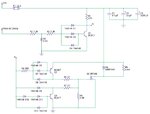alipoor90
Junior Member level 2

I came up with this circuit to control a 12V 6A fan's speed by a 5V PWM from another circuit, not sure if it's gonna work (i'm not very experienced nor knowledgeable in electronics), and i have a few questions:
1- to compensate for Q1's Vce, and turn off Q4 completely and reliably, when Q1 in on and A is low, i added one extra diode in series with Q4's base (total 2), is this a good idea? is it necessary as i thought?
2- are D4, D5 and D12 necessary in this circuit? (i put them there as part of baker clamp for each transistor, to charge/discharge the base faster when switching)
3- is there anything else that you think is unnecessary/lacking/wrong?

Thanks
1- to compensate for Q1's Vce, and turn off Q4 completely and reliably, when Q1 in on and A is low, i added one extra diode in series with Q4's base (total 2), is this a good idea? is it necessary as i thought?
2- are D4, D5 and D12 necessary in this circuit? (i put them there as part of baker clamp for each transistor, to charge/discharge the base faster when switching)
3- is there anything else that you think is unnecessary/lacking/wrong?

Thanks
Last edited:


